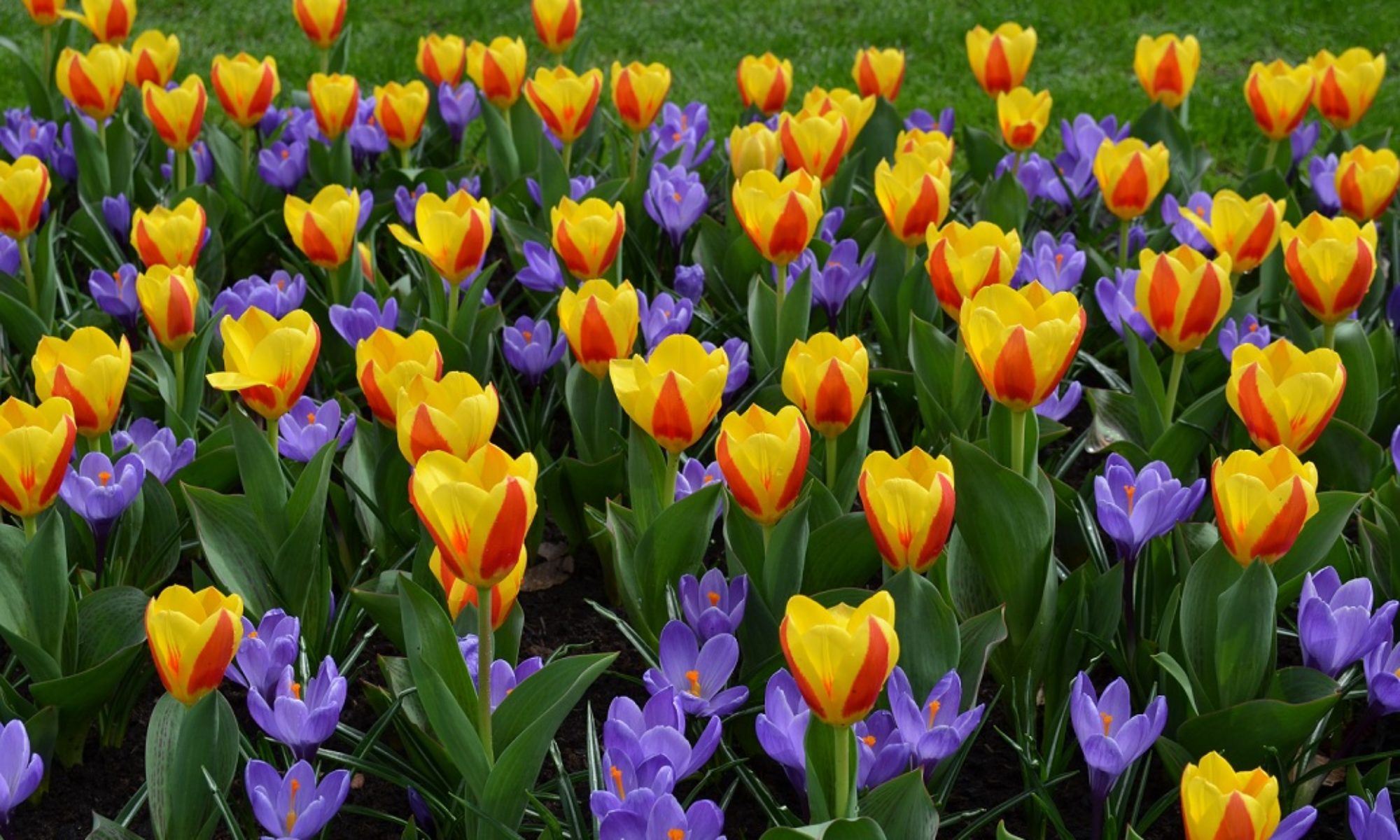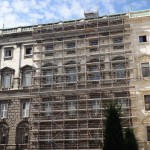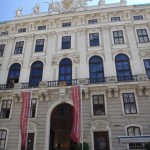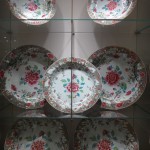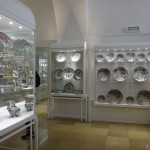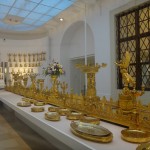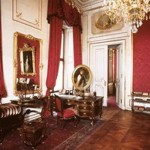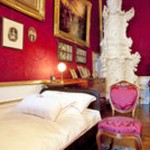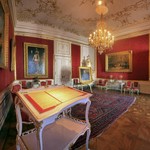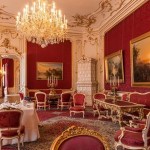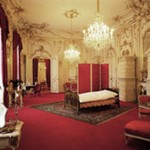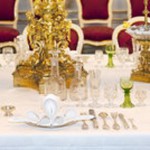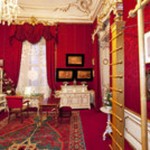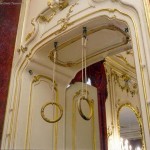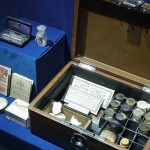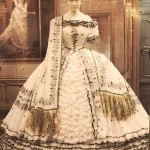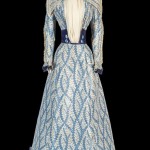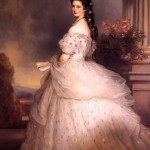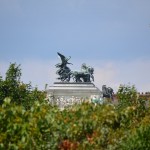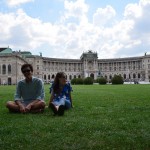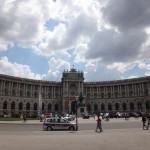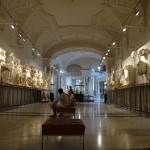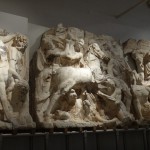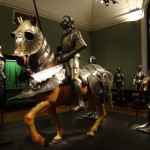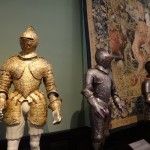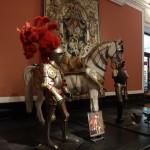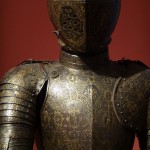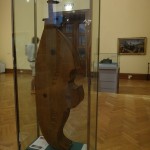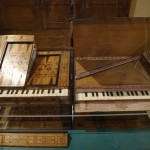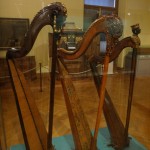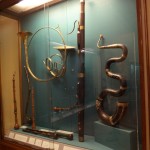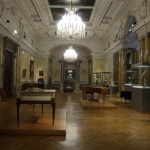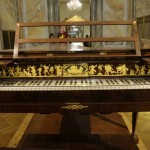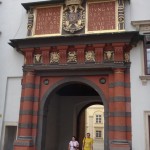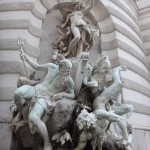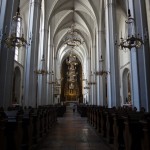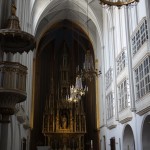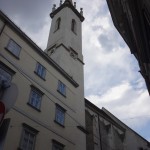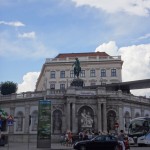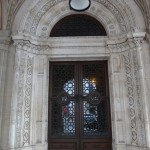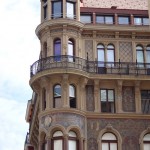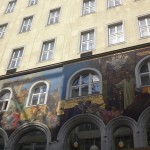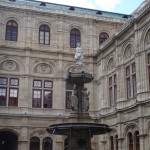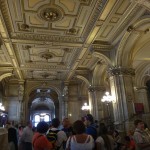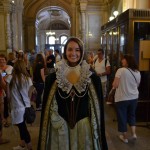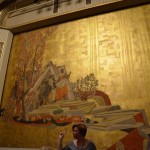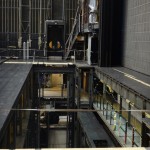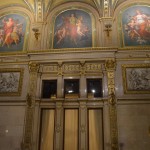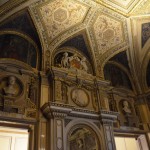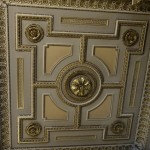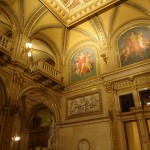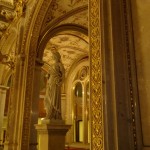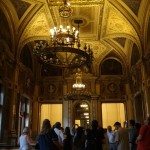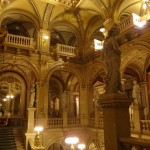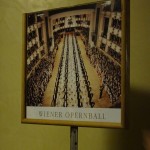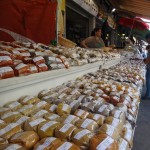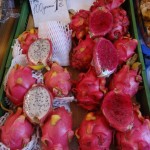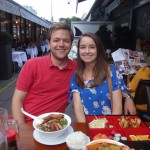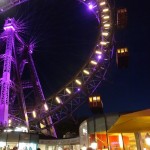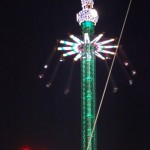We started off the day at another palace – this time at the Hofburg Imperial Palace. This was the principal/winter home (Schönbrunn Palace was for the summer) of the Habsburg dynasty, rulers of the Austro-Hungarian Empire. The Hofburg covers 240,000 square meters and is rightly described as a “city within a city”. Since it is such a huge complex, we focused on a few main points in the old castle: the Imperial Apartments, the Sisi Museum, and the Silver collection. Then we went over to the New Castle to see the Ephesos Museum and the Collection of Ancient Musical Instruments. Plus we did a bit of walking around the outside and visited the Augustine Church. Unfortunately the Winder Riding School was closed for a summer break, so we didn’t get to go inside or see the horses. L
First we checked out the Silver Collection – which includes a whole lot more than silver. There is a huge display of beautifully painted porcelain, Empress Maria Theresa’s personal set of eating utensils (made of solid gold) which went wherever she did, the Gold Service (porcelain covered in polished gold), and the Milan Table Centerpiece (commissioned for the coronation of Emperor Ferdinand) which can be extended to 30 meters long!
Next we toured the Sisi Museum which has loads of her personal belongings – dresses & parasols, gloves, her traveling medical chest, game case, and even her death mask (kind of creepy..). But the objects are laid out in a way to take you through her entire life – her childhood in Bavaria, her betrothal to Emperor Franz Joseph in 1853 (at age 15), how her life completely changed once she moved to court (her life ruled by protocol and ceremony), all the effort she put in to her looks (including taking care of her ANKLE length hair), how her son Rudolf’s suicide affected her (she wore mourning for the rest of her life and traveled constantly), and finally her assassination while in Switzerland. We weren’t allowed to take pictures in this area, so I’ve gotten some off the internet. Sisi’s medicine chest had cocaine in it, apparently this used to be administered for depression and for period cramps! SIDE NOTE on Sisi’s travels – one place she loved to go to was Corfu where she built the Achilleion palace – we visited this a little over a year later while on our 4 year anniversary cruise!
Then we walked through the imperial apartments, seeing the various rooms used by the Emperor and Empress. They had separate bedrooms and salon’s to use during the day. Sisi’s dressing room is where she had her bath, where her hairdresser fixed her hair (it took about 3 hours to comb it out and style it), and where she did some exercise (got to keep your 16 inch waist). Did I mention she washed her hair with washed in egg yolks and cognac? I’m not sure how you get that out of your floor length hair…. Franz Joseph’s study was also interesting- filled with portraits of friends and family this is where he started his work day at 4am (yuck).
After seeing the apartments, we walked around outside to the New Castle to tour the Ephesos Museum and the Collection of Ancient Musical Instruments. The inside of this building is beautiful – white marble everywhere and huge chandeliers. Now about the exhibits we saw. Ephesus, located in present-day Turkey, was one of the most important cities of antiquity. It was here that the Artemis Temple, one of the Seven Wonders of the World, stood; the city was also the home of Heraclitus, as well as of one of the largest early-Christian communities. Since 1895, Austrian archaeologists have been excavating the ruins of Ephesus. Up to the year 1906, numerous recovered objects of high quality were removed to Vienna. The highlights include the Parthian Monument, the Amazon from the Altar of the Artemision, the bronze Athlete statue and the Child with a Goose. SIDE NOTE again – we visited Ephesus while on our 4 year anniversary cruise as well!
We also walked through the Collection of Arms and Armour which is pretty extensive since the Hapsburgs were connected so many different countries through marriage. For this reason, nearly all western European princes from the 15th to the early 20th centuries are represented with armour and ornamental weapons. And finally, we saw the Collection of Historical Musical Instruments which is home to the most important collection of renaissance and baroque instruments worldwide. There were so many unusual instruments that I had never seen before for example the Clavicitherium, the Baryton, and the Zither.
When we left the Hofburg we visited the Vienna Opera House, which is pretty amazing. The lighting wasn’t the best when we visited, so the pictures of the polished Kaiserstein marble staircase do not do it justice. Towards the end of WWII the Opera was bombed. Thankfully The front section, which had been walled off as a precaution, remained intact including the foyer, with frescoes by Moritz von Schwind, the main stairways, the vestibule and the tea room. Sadly the auditorium and stage were, however, destroyed by flames as well as almost the entire décor and props for more than 120 operas with around 150,000 costumes. Thankfully it was rebuilt to match the section that had survived (they toyed with the idea of tearing the entire thing down and rebuilding from scratch), but our tour guide mentioned that the auditorium is not as grand as it was originally. The pictures back stage also don’t do it justice. The stage doesn’t exactly appear small — it’s 88 feet high — but behind the curtain it’s four times the size of the massive auditorium. The ginormous stage allows for different sets to rotate using hydraulic lifts that require so much power the Vienna Opera has two of its own substations. Did I mention it is the busiest opera house in the world (50-60 operas and 10 ballet productions a year result in approximately 300 performances)? Also they never perform the same show two nights in a row. And speaking of huge, the chandelier is three tons of Bohemian crystal with 1,100 bulbs spanning 22 feet in diameter and 16 feet high. Finally, I have a couple of pictures which show what the auditorium looks like when they set up for the Opera Ball. I’m thinking we should sign up for next year?! An entrance ticket is only €290 (but if you’re going to do it, you have to do it right and get a box for € 20.500).
We ate dinner at the Naschmarkt which was a perfect way to enjoy the nice weather since there was lots of outdoor seating available. We ended up at an Asian inspired place where the boys could eat some exotic food (and I played it pretty safe). In addition to restaurants, they also have stalls selling fruit & veggies, spices and souvineers (Morgan & Mathias bought jerseys and we this is where we bought Abbie & Isa’s dirdls). After dinner our last stop was the Prater, which is a huge amusement park best known for its huge Ferris wheel.
